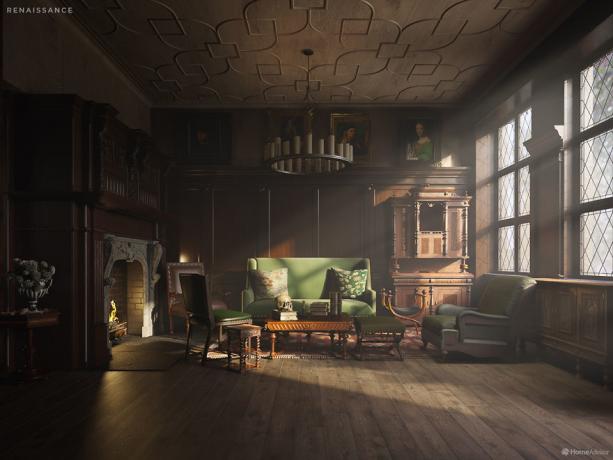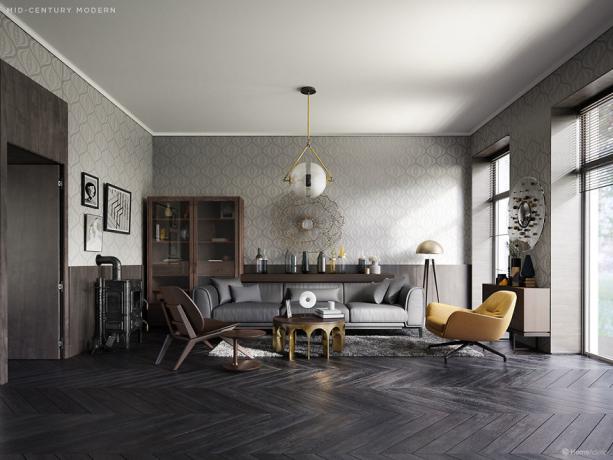600 years of interior design in the 12 illustrations
News Inspiration / / December 19, 2019
Designers with HomeAdvisor site created an interesting project, in which they showed how to look fashionable living roomsMade in key design styles for over 600 years - from the XV century to the present time.
It is worth noting that this is not authentic examples of the design of those years, and started from scratch with interiors taking into account the major trends of the time - with some inaccuracies and assumptions.
Renaissance (1400 - 1600)

Art and culture were reborn in the era of the French Renaissance, which quickly spread to the whole of Europe. Architects again carried away with fine detail and inspiration they served trends of freedom and humanism. Attention to the geometry and symmetry added harmony European interiors.
Wardrobe is made in the form of a palazzo (palace) - it is a popular trend at the time. Columns and balconies duplicate the shape of the building, increasing the sense of harmony. Turkish carpet on the floor is inspired by a painting by Hans Holbein the Younger, German painter, who lived in London during the Renaissance. These rugs have started to do in Turkey, from the XIV century, and they have become very popular in the Renaissance interior design.
Baroque (1590 - 1725)

In the Baroque era Turkish carpets out of fashion, the replacement by a more artsy furniture and decorative elements. The idea quickly caught the Catholic Church: a style to help her impress the uneducated masses, demonstrating the luxury and power. That is why the design of that time buried gold. Also popular were expensive exotic materials such as ivory, and the surface of the floor and tables are often made of marble.
Rococo (1720 - 1780)

By the end of the Baroque in focus was the Rococo style - but he was popular only three decades during the reign of Louis XV. It is more easy, friendly and free, than baroque. Some thought that he was better suited for the interior of the house, rather than church-pretentious baroque.
This style was popular floral and shell motifs, which added interior comfort and playfulness. In the XVIII century are popular pets balls - and Rococo allow the householder to show the richness and not as demonstratively stiffly.
Neoclassicism (1780 - 1880)

End georginskoy era has opened a new chapter in the history of architecture, which was a response to the Baroque and Rococo. It marked a return to the traditions of Roman and Greek culture and monumental design principles, free from the baroque splendor and novelty.
The living room of this period you will see the strict geometric lines and thoughtful, almost mathematically a calculated location of objects. Note the columnar clearance fireplaces, lamps and panels on the walls. The colors were muted, the designers did not strive for contrast. Single color design symbolizes stoic, superb sense of form, which glorified the neoclassicism.
"Arts and Crafts" (1860 - 1910)

This movement originated in England as a protest art mechanization in the era of industrialization. It is not a style, and approach back design and creation of the interior back into the hands of masters, not automating production. The design of this period were valued quality materials, simplicity and contact with nature.
The idea of "Arts and Crafts" and spread to other countries. In America, the most popular designers working with this course, was Gustav Stickley. His work is inspired by the design with large, rough shapes and an emphasis on wood and bronze.
Art Nouveau (1890 - 1920)

The beginning of XX century was marked by the emergence of new art - and it was called "Art Nouveau" (literal translation into French). Designers combine items handmade with new production techniques, it was not cheap in those days. Furniture and decorative elements were extravagant and emphasized modern. Here shows the influence of Japanese art that Europeans first saw only at the end of the XIX century.
Art Deco (1920 - 1960)

If the Bauhaus and modernism (more about them later) sought to use the technological advantages of the century, Art Deco was a lot more glamorous. The designers sought inspiration in geometry and movement of the era of machines and materials, and the symbolism of ancient cultures, and nature. And they are confident it is all mixed together.
Designers created a sense of wealth, using a wide range of materials, including lacquered wood, stained glass, stainless steel, aluminum, leather, and even jewelry. Bold colors and striking contrasts were designed to demonstrate the strength and confidence.
Modernism (1880 - 1940)

As is the case with the "Arts & Crafts" Modernism (not to be confused with modernity!) - more philosophy than the style itself. "House - a machine, in which people live" - this quote by Le Corbusier, the founder of modernism, can be characterized by its essence.
In the living room using the latest materials and technology. The main task of the designer was to make the room comfortable, functional and affordable. Beauty was a nice bonus, although elegant solutions in compliance with other rules only encouraged.
Bauhaus (1919 - 1934)

The name came from the Bauhaus style of the same name of the German school of art and architecture (which is why the style name is spelled with a capital letter). Bauhaus can be considered more radical offshoot of Modernism. The shape was dictated by destiny: the furniture structure was the most utilitarian, decorative elements are not used.
Modern mid-century (1930 - today)

This style is softer, perhaps even a provincial version of modernism, with more extensive use of natural materials. Designers use color more freely, with no longer dominated by dark colors, and the color schemes in the Scandinavian and Brazilian style.
Materials such as rattan and bamboo seem both natural and modern, when they are used for the seats, mirrors and trim. Lampshade and a floor lamp on this rendering borrows formal elements of modernism and Bauhaus, but look more interesting, as the stylized lamps for outdoor lighting, which brought in house.
Postmodern (1978 - today)

The interior of the postmodern style is inspired by the works of surrealists like Marcel Duchamp and pop art (think of Andy Warhol). Simply put, the designers finally thrown off the shackles of modernism and came to create interiors with a sense of humor and brash confidence. In such an interior every thing has its place and value - and, as a rule, not even one. Characteristic features are the flashy color schemes and the desire to create optical illusions.
Modern Style (1980 - today)

Actual contemporary style borrowed from modernist clarity of lines, and in the middle of the century Art Nouveau - a sense of air, open space. At the end of the 2010s designers began to pay tribute and Bauhaus, exposing carcass furniture. New advanced materials are often combined with a stylized industrial.
Smooth, light floor and not overloaded walls enhance the feeling of light and open space. In the above image abstract painting does not allow the walls seem dull empty, and the use of thin lines (eg lamps) visually expands the room.
Here is a video in which collected all the illustrations. It perfectly demonstrates how design styles were replaced over the past 6 centuries.
see also🧐
- 11 ways to transform the interior of the kitchen and not go broke
- 12 ways to transform the interior of the bedroom without repair
- "On paper, it looked better": 15 examples are not very good design



